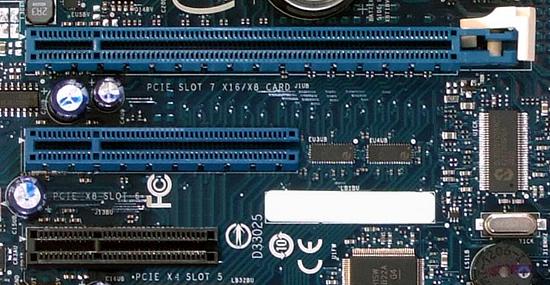- Related articles
- Optical Transceivers for Cisco SG350XG-24T-K9-UK Switch
- Optical Transceivers for Cisco WS-C2960S-48FPD-L Switch
- Optical Transceivers for Cisco UCS-FI-6248UP-CH2 Switch
- Optical Transceivers for Cisco SRW248G4-K9-EU Switch
- What Is Network Card PCI Express x4?
- What is a DWDM transceiver?
- All Cisco ONS-SI-2G-L1's information (List price, Specs, Datasheet PDF, Compatibility matr
- All Cisco GLC-FE-100BX-U's information (List price, Specs, Datasheet PDF, Compatibility ma
- All Cisco XFP-10GZR-OC192LR’s Information (Overview, Features, Datasheet PDF, Price, Speci
- Optical Transceivers for Cisco WS-C3560E-48PD-S Switch

PCI Express (Peripheral Component Interconnect Express), officially abbreviated as PCIe, is a high-speed serial computer expansion bus standard, designed to replace the older PCI, PCI-X, and AGP bus standards. PCIe has numerous improvements over the older standards, including higher maximum system bus throughput, lower I/O pin count and smaller physical footprint, better performance scaling for bus devices, a more detailed error detection and reporting mechanism (Advanced Error Reporting, AER), and native hot-plug functionality. More recent revisions of the PCIe standard provide hardware support for I/O virtualization.
The PCI Express electrical interface is also used in a variety of other standards, most notably in ExpressCard as a laptop expansion card interface, and in SATA Express as a computer storage interface.
Format specifications are maintained and developed by the PCI-SIG (PCI Special Interest Group), a group of more than 900 companies that also maintain the conventional PCI specifications. PCIe 3.0 is the latest standard for expansion cards that are in production and available on mainstream personal computers.

Difference between Express 1.0, 2.0 And 3.0
PCI Express is organized into lanes. Each lane has an independent set of transmit and receive pins, and data can be sent in both directions simultaneously. And here’s where things get misleading. Bandwidth in a single direction for a single PCIe 1.0 lane (x1) is 250MB/s, but because you can send and receive 250MB/s at the same time Intel likes to state the bandwidth available to a PCIe 1.0 x1 slot as 500MB/s. While that is the total aggregate bandwidth available to a single slot, you can only reach that bandwidth figure if you’re reading and writing at the same time.
PCI Express 2.0 doubles the bidirectional bandwidth per lane. Instead of 250MB/s in each direction per lane, you get 500MB/s.
Other than graphics, there haven’t been any high bandwidth consumers on the PCIe bus in desktops. Thus the distinction between PCIe 1.0 and 2.0 has never really mattered. Today, both USB 3.0 and 6Gbps SATA aim to change that. Both can easily saturate a PCIe 1.0 x1 connection.
Besides the big difference on the maximum theoretical bandwidth between the CPU and GPU, we were still curious about the real-life performance impact on games by using a PCI Express 3.0 against a 2.0 connection. So, we ran 3D benchmarks using 3DMark and some recent games, using a high-end video card (which, in theory, demands more bandwidth than a mainstream or value one), first with the slot configured as PCI Express 3.0 x16, then with the same slot configured as PCI Express 2.0 x16. Finally, we tested with the same video card, but this time using a slot that supports up to PCI Express 3.0 x4, to check if an ever lower bandwidth could affect performance.
What is Express 1.0?
"The first generation of PCIe is generally referred to as Gen 1 (PCI Express 1.0). This generation includes two specifications: PCIe 1.0 and PCIe 1.1. PCIe 1.1 is an updated specification that includes the clarifications necessary for PCIe 1.0a.
Diodes provide a variety of PCIe Gen 1 solutions, including packet switchers, signal switchers, bridge drivers/relays and frequency solutions. Diodes also offer a wide range of bridge solutions that interconnect PCIe to PCI, PCI to PCIe, PCIe to PCI-X, PCIe to UART, and PCIe to USB 2.0 hub."
What is Express 2.0?
The second generation of PCIe is generally referred to as Gen 2. The data transfer rate of PCIe Gen2 is twice that of Gen 1, reaching 5 GT/s. In addition, PCIe Gen 2 is backward compatible with PCIe Gen 1, including line cards, motherboards, and backplane slots.
Diodes provide a variety of solutions applicable to PCIe Gen 2 for packet switching, signal switching, bridge driving/relaying, and frequency.
What is Express 3.0?
The recently introduced PCIe specification is generally referred to as PCIe Gen 3. In addition to increasing the data transfer rate to 8 GT/s, GEN 3 uses upgraded encoding/decoding methods that can reduce the transport overhead to less than 2% compared with Gen 1 and Gen 2.
Summary
The PCI Express backplane is ideal for video wall controllers, graphics processing and GPU computing system solutions. This backplane supports one single board computer & seventeen x16 PCI Express I/O option card slots. Each option card slot uses a x16 mechanical connector to maximize system design flexibility. The can take full advantage of PCI Express 2.0’s data throughput capacity when used with Trenton single board computers.





































































